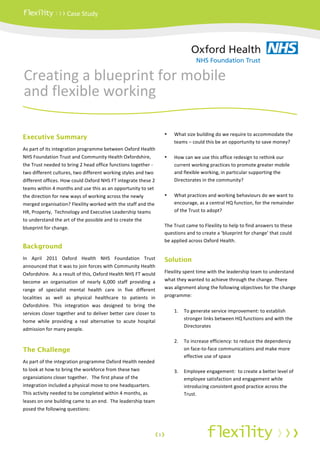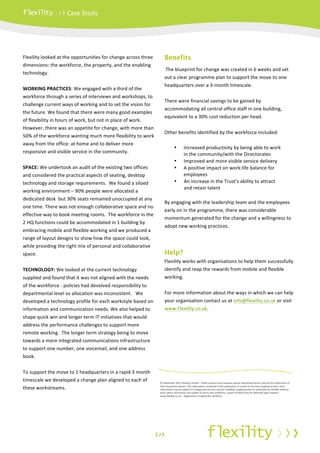Flexility case study - Oxford Health
- 1. Case ¬†Study ¬† ¬† ¬† Creating ¬†a ¬†blueprint ¬†for ¬†mobile ¬† ¬† and ¬†flexible ¬†working ¬† ¬† ¬† ¬† ‚ÄĘ What ¬†size ¬†building ¬†do ¬†we ¬†require ¬†to ¬†accommodate ¬†the ¬† Executive Summary teams ¬†‚Äď ¬†could ¬†this ¬†be ¬†an ¬†opportunity ¬†to ¬†save ¬†money? ¬† As ¬†part ¬†of ¬†its ¬†integration ¬†programme ¬†between ¬†Oxford ¬†Health ¬† ¬† NHS ¬†Foundation ¬†Trust ¬†and ¬†Community ¬†Health ¬†Oxfordshire, ¬† ‚ÄĘ How ¬†can ¬†we ¬†use ¬†this ¬†office ¬†redesign ¬†to ¬†rethink ¬†our ¬† the ¬†Trust ¬†needed ¬†to ¬†bring ¬†2 ¬†head ¬†office ¬†functions ¬†together ¬†-¬≠‚Äź ¬† current ¬†working ¬†practices ¬†to ¬†promote ¬†greater ¬†mobile ¬† two ¬†different ¬†cultures, ¬†two ¬†different ¬†working ¬†styles ¬†and ¬†two ¬† and ¬†flexible ¬†working, ¬†in ¬†particular ¬†supporting ¬†the ¬† different ¬†offices. ¬†How ¬†could ¬†Oxford ¬†NHS ¬†FT ¬†integrate ¬†these ¬†2 ¬† Directorates ¬†in ¬†the ¬†community? ¬† teams ¬†within ¬†4 ¬†months ¬†and ¬†use ¬†this ¬†as ¬†an ¬†opportunity ¬†to ¬†set ¬† ¬† the ¬†direction ¬†for ¬†new ¬†ways ¬†of ¬†working ¬†across ¬†the ¬†newly ¬† ‚ÄĘ What ¬†practices ¬†and ¬†working ¬†behaviours ¬†do ¬†we ¬†want ¬†to ¬† merged ¬†organisation? ¬†Flexility ¬†worked ¬†with ¬†the ¬†staff ¬†and ¬†the ¬† encourage, ¬†as ¬†a ¬†central ¬†HQ ¬†function, ¬†for ¬†the ¬†remainder ¬† HR, ¬†Property, ¬† ¬†Technology ¬†and ¬†Executive ¬†Leadership ¬†teams ¬† of ¬†the ¬†Trust ¬†to ¬†adopt? ¬† ¬† to ¬†understand ¬†the ¬†art ¬†of ¬†the ¬†possible ¬†and ¬†to ¬†create ¬†the ¬† ¬† blueprint ¬†for ¬†change. ¬† ¬† ¬† The ¬†Trust ¬†came ¬†to ¬†Flexility ¬†to ¬†help ¬†to ¬†find ¬†answers ¬†to ¬†these ¬† ¬† questions ¬†and ¬†to ¬†create ¬†a ¬†‚Äėblueprint ¬†for ¬†change‚Äô ¬†that ¬†could ¬† be ¬†applied ¬†across ¬†Oxford ¬†Health. ¬† ¬† Background ¬† ¬† In ¬† April ¬† 2011 ¬† Oxford ¬† Health ¬† NHS ¬† Foundation ¬† Trust ¬† Solution announced ¬†that ¬†it ¬†was ¬†to ¬†join ¬†forces ¬†with ¬†Community ¬†Health ¬† Oxfordshire. ¬† ¬†As ¬†a ¬†result ¬†of ¬†this, ¬†Oxford ¬†Health ¬†NHS ¬†FT ¬†would ¬† Flexility ¬†spent ¬†time ¬†with ¬†the ¬†leadership ¬†team ¬†to ¬†understand ¬† become ¬† an ¬† organisation ¬† of ¬† nearly ¬† 6,000 ¬† staff ¬† providing ¬† a ¬† what ¬†they ¬†wanted ¬†to ¬†achieve ¬†through ¬†the ¬†change. ¬†There ¬† range ¬† of ¬† specialist ¬† mental ¬† health ¬† care ¬† in ¬† five ¬† different ¬† was ¬†alignment ¬†along ¬†the ¬†following ¬†objectives ¬†for ¬†the ¬†change ¬† localities ¬† as ¬† well ¬† as ¬† physical ¬† healthcare ¬† to ¬† patients ¬† in ¬† programme: ¬† ¬† Oxfordshire. ¬† This ¬† integration ¬† was ¬† designed ¬† to ¬† bring ¬† the ¬† ¬† services ¬†closer ¬†together ¬†and ¬†to ¬†deliver ¬†better ¬†care ¬†closer ¬†to ¬† 1. To ¬†generate ¬†service ¬†improvement: ¬†to ¬†establish ¬† stronger ¬†links ¬†between ¬†HQ ¬†functions ¬†and ¬†with ¬†the ¬† home ¬† while ¬† providing ¬† a ¬† real ¬† alternative ¬† to ¬† acute ¬† hospital ¬† Directorates ¬† admission ¬†for ¬†many ¬†people. ¬† ¬† ¬† ¬† 2. To ¬†increase ¬†efficiency: ¬†to ¬†reduce ¬†the ¬†dependency ¬† The Challenge on ¬†face-¬≠‚Äźto-¬≠‚Äźface ¬†communications ¬†and ¬†make ¬†more ¬† effective ¬†use ¬†of ¬†space ¬† As ¬†part ¬†of ¬†the ¬†integration ¬†programme ¬†Oxford ¬†Health ¬†needed ¬† ¬† to ¬†look ¬†at ¬†how ¬†to ¬†bring ¬†the ¬†workforce ¬†from ¬†these ¬†two ¬† 3. Employee ¬†engagement: ¬† ¬†to ¬†create ¬†a ¬†better ¬†level ¬†of ¬† organsiations ¬†closer ¬†together. ¬† ¬† ¬†The ¬†first ¬†phase ¬†of ¬†the ¬† employee ¬†satisfaction ¬†and ¬†engagement ¬†while ¬† integration ¬†included ¬†a ¬†physical ¬†move ¬†to ¬†one ¬†headquarters. ¬† ¬† introducing ¬†consistent ¬†good ¬†practice ¬†across ¬†the ¬† This ¬†activity ¬†needed ¬†to ¬†be ¬†completed ¬†within ¬†4 ¬†months, ¬†as ¬† Trust. ¬† ¬† leases ¬†on ¬†one ¬†building ¬†came ¬†to ¬†an ¬†end. ¬† ¬†The ¬†leadership ¬†team ¬† ¬† posed ¬†the ¬†following ¬†questions: ¬† ¬† ¬† ¬† ‚ÄĻ1‚Äļ ¬†
- 2. Case ¬†Study ¬† ¬† ¬† Flexility ¬†looked ¬†at ¬†the ¬†opportunities ¬†for ¬†change ¬†across ¬†three ¬† Benefits dimensions: ¬†the ¬†workforce, ¬†the ¬†property, ¬†and ¬†the ¬†enabling ¬† ¬†The ¬†blueprint ¬†for ¬†change ¬†was ¬†created ¬†in ¬†6 ¬†weeks ¬†and ¬†set ¬† technology. ¬† ¬† ¬† out ¬†a ¬†clear ¬†programme ¬†plan ¬†to ¬†support ¬†the ¬†move ¬†to ¬†one ¬† ¬† headquarters ¬†over ¬†a ¬†3-¬≠‚Äźmonth ¬†timescale. ¬† ¬† ¬† WORKING ¬†PRACTICES: ¬†We ¬†engaged ¬†with ¬†a ¬†third ¬†of ¬†the ¬† ¬† workforce ¬†through ¬†a ¬†series ¬†of ¬†interviews ¬†and ¬†workshops, ¬†to ¬† There ¬†were ¬†financial ¬†savings ¬†to ¬†be ¬†gained ¬†by ¬† challenge ¬†current ¬†ways ¬†of ¬†working ¬†and ¬†to ¬†set ¬†the ¬†vision ¬†for ¬† accommodating ¬†all ¬†central ¬†office ¬†staff ¬†in ¬†one ¬†building, ¬† the ¬†future. ¬†We ¬†found ¬†that ¬†there ¬†were ¬†many ¬†good ¬†examples ¬† equivalent ¬†to ¬†a ¬†30% ¬†cost ¬†reduction ¬†per ¬†head. ¬† ¬† of ¬†flexibility ¬†in ¬†hours ¬†of ¬†work, ¬†but ¬†not ¬†in ¬†place ¬†of ¬†work. ¬† ¬† However, ¬†there ¬†was ¬†an ¬†appetite ¬†for ¬†change, ¬†with ¬†more ¬†than ¬† Other ¬†benefits ¬†identified ¬†by ¬†the ¬†workforce ¬†included: ¬† ¬† 50% ¬†of ¬†the ¬†workforce ¬†wanting ¬†much ¬†more ¬†flexibility ¬†to ¬†work ¬† ¬† away ¬†from ¬†the ¬†office: ¬†at ¬†home ¬†and ¬†to ¬†deliver ¬†more ¬† ‚ÄĘ Increased ¬†productivity ¬†by ¬†being ¬†able ¬†to ¬†work ¬† ¬† responsive ¬†and ¬†visible ¬†service ¬†in ¬†the ¬†community. ¬† ¬† in ¬†the ¬†community/with ¬†the ¬†Directorates ¬† ¬† ‚ÄĘ Improved ¬†and ¬†more ¬†visible ¬†service ¬†delivery ¬† SPACE: ¬†We ¬†undertook ¬†an ¬†audit ¬†of ¬†the ¬†existing ¬†two ¬†offices ¬† ‚ÄĘ A ¬†positive ¬†impact ¬†on ¬†work:life ¬†balance ¬†for ¬† and ¬†considered ¬†the ¬†practical ¬†aspects ¬†of ¬†seating, ¬†desktop ¬† employees ¬† technology ¬†and ¬†storage ¬†requirements. ¬† ¬†We ¬†found ¬†a ¬†siloed ¬† ‚ÄĘ An ¬†increase ¬†in ¬†the ¬†Trust‚Äôs ¬†ability ¬†to ¬†attract ¬† ¬† and ¬†retain ¬†talent ¬† working ¬†environment ¬†‚Äď ¬†90% ¬†people ¬†were ¬†allocated ¬†a ¬† ¬† dedicated ¬†desk ¬† ¬†but ¬†30% ¬†seats ¬†remained ¬†unoccupied ¬†at ¬†any ¬† By ¬†engaging ¬†with ¬†the ¬†leadership ¬†team ¬†and ¬†the ¬†employees ¬† one ¬†time. ¬†There ¬†was ¬†not ¬†enough ¬†collaborative ¬†space ¬†and ¬†no ¬† early ¬†on ¬†in ¬†the ¬†programme, ¬†there ¬†was ¬†considerable ¬† effective ¬†way ¬†to ¬†book ¬†meeting ¬†rooms. ¬† ¬†The ¬†workforce ¬†in ¬†the ¬† momentum ¬†generated ¬†for ¬†the ¬†change ¬†and ¬†a ¬†willingness ¬†to ¬† 2 ¬†HQ ¬†functions ¬†could ¬†be ¬†accommodated ¬†in ¬†1 ¬†building ¬†by ¬† adopt ¬†new ¬†working ¬†practices. ¬† ¬† embracing ¬†mobile ¬†and ¬†flexible ¬†working ¬†and ¬†we ¬†produced ¬†a ¬† range ¬†of ¬†layout ¬†designs ¬†to ¬†show ¬†how ¬†the ¬†space ¬†could ¬†look, ¬† while ¬†providing ¬†the ¬†right ¬†mix ¬†of ¬†personal ¬†and ¬†collaborative ¬† space. ¬† ¬† Help? ¬† Flexility ¬†works ¬†with ¬†organisations ¬†to ¬†help ¬†them ¬†successfully ¬† TECHNOLOGY: ¬†We ¬†looked ¬†at ¬†the ¬†current ¬†technology ¬† identify ¬†and ¬†reap ¬†the ¬†rewards ¬†from ¬†mobile ¬†and ¬†flexible ¬† supplied ¬†and ¬†found ¬†that ¬†it ¬†was ¬†not ¬†aligned ¬†with ¬†the ¬†needs ¬† ¬† working. ¬† ¬† of ¬†the ¬†workforce ¬†-¬≠‚Äź ¬†policies ¬†had ¬†devolved ¬†responsibility ¬†to ¬† ¬† departmental ¬†level ¬†so ¬†allocation ¬†was ¬†inconsistent. ¬† ¬† ¬†We ¬† For ¬†more ¬†information ¬†about ¬†the ¬†ways ¬†in ¬†which ¬†we ¬†can ¬†help ¬† developed ¬†a ¬†technology ¬†profile ¬†for ¬†each ¬†workstyle ¬†based ¬†on ¬† your ¬†organisation ¬†contact ¬†us ¬†at ¬†info@flexility.co.uk ¬†or ¬†visit ¬† information ¬†and ¬†communication ¬†needs. ¬†We ¬†also ¬†helped ¬†to ¬† www.Flexility.co.uk. ¬† ¬† shape ¬†quick ¬†win ¬†and ¬†longer ¬†term ¬†IT ¬†initiatives ¬†that ¬†would ¬† ¬† address ¬†the ¬†performance ¬†challenges ¬†to ¬†support ¬†more ¬† ¬† remote ¬†working. ¬† ¬†The ¬†longer ¬†term ¬†strategy ¬†being ¬†to ¬†move ¬† ¬† towards ¬†a ¬†more ¬†integrated ¬†communications ¬†infrastructure ¬† ¬† to ¬†support ¬†one ¬†number, ¬†one ¬†voicemail, ¬†and ¬†one ¬†address ¬† ¬† book. ¬† ¬† ¬† ¬† ¬† ¬† To ¬†support ¬†the ¬†move ¬†to ¬†1 ¬†headquarters ¬†in ¬†a ¬†rapid ¬†3 ¬†month ¬† timescale ¬†we ¬†developed ¬†a ¬†change ¬†plan ¬†aligned ¬†to ¬†each ¬†of ¬† ¬© ¬†September ¬†2012 ¬†Flexility ¬†Limited ¬†‚ÄĘ ¬†Other ¬†product ¬†and ¬†company ¬†names ¬†m entioned ¬†herein ¬†m ay ¬†be ¬†the ¬†trademarks ¬†of ¬† these ¬†workstreams. ¬† their ¬†respective ¬†owners. ¬†The ¬†information ¬†contained ¬†in ¬†this ¬†publication ¬†is ¬†correct ¬†at ¬†the ¬†time ¬†of ¬†going ¬†to ¬†print. ¬†Such ¬† information ¬†m ay ¬†be ¬†subject ¬†to ¬†change ¬†and ¬†services ¬†m ay ¬†be ¬†m odified, ¬†supplemented ¬†or ¬†withdrawn ¬†by ¬†Flexility ¬†without ¬† prior ¬†notice. ¬†All ¬†services ¬†are ¬†subject ¬†to ¬†terms ¬†and ¬†conditions, ¬†copies ¬†of ¬†which ¬†m ay ¬†be ¬†obtained ¬†upon ¬†request ¬†‚ÄĘ ¬† ¬† www.flexility.co.uk ¬†‚ÄĘ ¬†Registered ¬†in ¬†England ¬†No. ¬†6578126 ¬† ¬† ¬† ¬† ¬† ¬† ‚ÄĻ2‚Äļ ¬†


